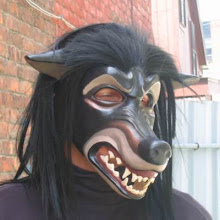
Well, I have concluded my experiments with Aves products and maskmaking, at least for the immediate future. As a last step, I turned over my Aves Paper Mache/Fixit Paste mask to my Materials Testing Department, aka my three year old daughter Isabelle, and it survived the experiment just fine. Un/fortunately, with all the collections of this that and the other in the house, Isabelle has learned to be very gentle with things so I may have to take a turn beating on the mask myself and see what happens.
I tried casting "Rip" masks in both unadulterated Fixit Paste and a combination of Fixit Paste and Aves Paper Mache. I've found that these masks come out to be about twice as heavy as the Paperclay/Sculpt and Coat masks, which with a mask the size of Rip is wearable but not at all comfortable. (The Paperclay masks come out to be about 8 oz, the Aves masks come out to be about 1 # 4 oz.) It's possible these materials might still have uses in smaller masks, where twice the weight may still not make a noticeable difference.
The Aves Paper Mache (and a similar product, Aves Clayshay) casts like an absolute dream, very easy to handle with no warping or shrinking, though the raw cast does have a lot of pinholes that need to be filled. Unfortunately the Paper Mache (and Clayshay) is much too fragile in the thicknesses required from maskmaking and unless it is reinforced with another material, falls completely apart during demolding. The Aves Fixit Paste is much stronger, but is more difficult to use, having the resemblance that it does to taffy left in a rear windsheild on a summer day. It also does not adhere well to vertical surfaces in a rubber mold, so it pools in the bottom, making for a cast very uneven in thickness. It can be cast over an initial coat of Paper Mache, which helps with this issue somewhat. In my experiments it tended to have fewer pinholes than the Paper Mache, but the ones it has are much more difficult to fix, since the Fixit Putty used to fill them is trickier to handle.
I also tried Aves Apoxie Paste, which is a little cheaper and adheres better to vertical surfaces. When dry, however, it has an unfortunate resemblance to dried snot, not at all what I want my masks to feel like! It's interesting, I hadn't thought of disqualifying a material because of the way it's *felt* before.
Oh well. I was hoping that the decreased casting time for these materials might translate into fewer production hours per mask, and thus lower prices. Since it is very important to me for my masks to be comfortable to wear, however, I think the extra weight disqualifies these materials from extensive usage on my part.



No comments:
Post a Comment